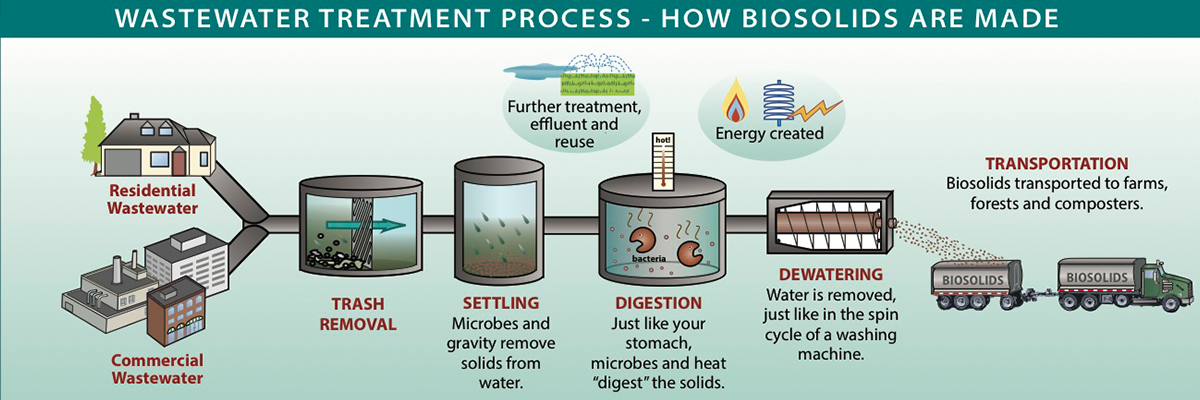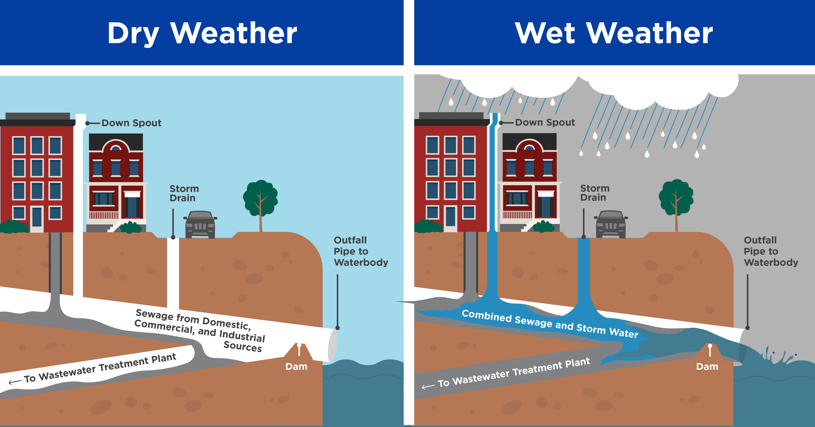Frequently Asked Questions
Metering stations throughout the service area and also at the pumping station and start of the wastewater treatment facility give the operators real-time flow data for use to plan for optimal treatment of the wastewater.
The District bills an annual “assessment” from each of its member communities, payable in four installments typically. Individual users are not billed directly, i.e., residents. Please see the budget page for more information.
The GLSD wastewater treatment plant provides two types of treatment: wastewater treatment and biosolids treatment. These two types of treatment are described as follows:
Wastewater Treatment: Virtually all the wastewater entering the GLSD plant passes through the main pumping station known as the Riverside Pumping Station. This station has the capacity to pump up to 165 million gallons per day of wastewater. At the treatment plant, the wastewater passes through various stages of treatment:
- Preliminary Treatment to remove grit and screenings, i.e., trash
- Primary Clarification for removal of solids in the wastewater;
- Aeration Treatment for removal of organics remaining in the wastewater after primary clarification;
- Disinfection to destroy harmful pathogenic organisms in the treated wastewater;
- Discharge back to the Merrimack River.
Bisolids Treatment: Both the primary clarification and aeration treatment processes produce biosolids, which are further treated. The “Biosolids Improvement Project” completely revamped the treatment of biosolids at the GLSD. The following summarizes the new biosolids treatment system:
- Gravity Thickening for initial removal of water from biosolids settled by the Primary Clarification process.
- Gravity Belt Thickening for initial removal of water from biosolids originating in the Aeration Treatment process.
- Anaerobic Digestion: This process receives the biosolids from the two thickening processes. Anaerobic Digestion is a biological process that performs several functions:
- Breaking down organic matter into simple compounds thereby stabilizing the biosolids and reducing its odor potential;
- Reducing the concentration of pathogenic organisms present in the sludge, and producing methane gas that is utilized as a fuel.
- Centrifuge Dewatering removes additional water from the biosolids transforming it into a solid material that is then sent to the onsite drying facility where it is processed and converted into dry pellets that can be utilized as a fertilizer and soil conditioner.
- Although not part of the sludge treatment process, the Biosolids Improvement Project also includes a new “Biofilter” for control of odors produced during sludge processing.
The number of GLSD commissioners (for Massachusetts communities) is set forth in the enabling legislation that established the District Chapter 750 of the Acts of 1968. Section 2 of that legislation states that the commission “shall consist of three members from the City of Lawrence, two members from the Town of Methuen, one member from the Town of Andover, and one member from the Town of North Andover”. The legislation generally indicates that the number of commissioners for each community is established on a population basis and may change due to population increases in each community.
Salem, NH joined the District in 1982 through a formal agreement between the District and the town. Section 11 of this agreement provides that Salem shall have one non-voting representative to the commission. GLSD and Dracut, MA entered into an agreement in 2007 for wastewater services.
Population* of District:
| Location | 1977 | 2010 | 2020 |
| Andover | 25,600 | 33,201 | 36,569 |
| Lawrence | 64,300 | 76,377 | 89,143 |
| Methuen | 36,300 | 47,255 | 53,059 |
| North Andover | 19,000 | 28,352 | 30,915 |
| Salem | N/A | 41,340 | 30,483 |
| Dracut | N/A | 29,457 | 32,617 |
| Total | 145,200 | 226,525 | 247,929 |
*Please note that some of the population shown for each of the communities is not yet served by public sewers. These numbers are based on the town census in 2010 and federal census of 2020. To calculate the total population served, one quarter of Dracut’s population was used.
The Merrimack River’s quality has greatly improved since the plant began operation in 1977. Bacterial counts are lower by orders of magnitude, the river now generally meets water quality standards for dissolved oxygen, and except during wet weather conditions, discharges of solids and grease have ceased.
Examples of improvements:
- “Coliform”: Coliform refers to a group of related bacteria that are often used as an indicator of the degree to which a waterbody is contaminated by pathogenic organisms. Although Massachusetts no longer has a standard for (total) coliform levels in rivers and streams, New Hampshire’s standard is “no sample greater than 406 counts per 100 milliliters”.
- Coliform counts in the Merrimack River below Lawrence:
- 1963 Data: Average of all samples = 4,850,000 counts per 100 milliliters.
- 1994 Sample: Result = 190 counts per 100 milliliters.
- Coliform counts in the Merrimack River below Lawrence:
- “Dissolved Oxygen”: The dissolved oxygen level in a waterbody is one measure of its level of pollution by organic substances, such as contaminants in sewage. For a river body such as the Merrimack, the Massachusetts standard for dissolved oxygen level is “not less than 5.0 milligrams per liter.” Levels below the standard are evidence of significant contamination and could be harmful to fish.
- Dissolved Oxygen Levels in River below Lawrence:
- 1963 Data: Average of all samples = 2.4 milligrams per liter (Some samples showed complete depletion (i.e., Ð 0) of dissolved oxygen.
- 1994 Sample: Result = 7.97 milligrams per liter (higher number is better for this parameter).
- Dissolved Oxygen Levels in River below Lawrence:
A 1963 study by Camp, Dresser & McKee (before treatment plants) summarized then prevailing conditions at that time as follows:
- “Our investigations and studies indicate that the Merrimack River is polluted from the New Hampshire state line down to the Atlantic Ocean. The pollution resulting from excessive bacterial counts makes any type of recreational use of the river hazardous to the public health. This bacterial pollution results almost entirely from the discharge of untreated sanitary sewage into the river. The pollution resulting from excessive decomposable organic matter causes depletion of oxygen content of the river water during dry weather and is sufficient to cause odor nuisance and be dangerous to fish life. In addition to bacterial and organic pollution, the discharge of floating solids and grease causes unsightly nuisance conditions on the river and its banks.”
GLSD is one of several wastewater treatment plants along the Merrimack River that collectively protect the quality of Merrimack River waters. There are roughly 135 treatment plants in Massachusetts all together.
GLSD processes approximately 75,000 gallons of septage per day from the six District communities and several others. Septage represents less than 1 percent of the flow to the wastewater treatment facility.
In a typical year, the plant treats approximately 30 million gallons per day of wastewater which corresponds to 900 million gallons per month or 11 billion gallons per year.
The Greater Lawrence Sanitary District receives and treats wastewater from six communities: Lawrence, Methuen, Andover, North Andover, Dracut, MA, and Salem, NH.
The Greater Lawrence Sanitary District plant opened in April of 1977.
Biosolids are the nutrient-rich, organic byproducts resulting from wastewater treatment. Typically, biosolids are dumped in landfills or incinerated. Our biosolids are treated such that they become an alternative to commercial fertilizers. See Diagram and steps outlined below for more information.

Credit to NorthWest Biosolids
Step 1: Wastewater is generated at residences, commercial spaces and industries and is conveyed to the wastewater treatment plant via underground pipes.
Step 2: Trash is removed from the wastewater – so it doesn’t end up in the river.
Step 3: Solids in wastewater settle to the bottom of specialized tanks. Clean water is further treated and discharged to the Merrimack River.
Step 4: Anaerobic digesters – like our stomachs –these tanks break down biosolids which produce biogas, an alternative to natural gas that is used to fuel a combined heat and power facility that produces electricity and heat.
Step 5: Dewatering removes a portion of the water from the digested biosolids by spinning them at high speeds.
Step 6: Heat Drying – GLSD takes it one more step – we further dry the biosolids to produce a reusable fertilizer pellet in rotary drum dryers.
Step 7: Biosolids are transported to farms, forests, and composters for reuse instead of disposal in landfills or incinerators. The material is 95% solids and only 5% water. The use of this material lessens the need to depend on commercial fertilizers produced with fossil fuels, it sequesters carbon from the environment, and helps maintain moisture when used on farmland.
By adding food waste to our anaerobic digesters, the quantity of biogas produced has nearly quadrupled – allowing GLSD to power engines to produce our own electricity and heat used on site. Biogas is mostly methane and can be used in place of natural gas – lessening our reliance on pipeline gas.
Three major odor control processes have been added to the GLSD since commencing operation in 1977:
1) Dual carbon vessels remove odors at the Riverside Pumping Station
2) An air scrubber at the treatment plant removes odors from the grit removal and screenings buildings, which are the first two treatment processes, and
3) Finally, since the completion of the Biosolids Improvement Project in 2000, all sludge treatment processes at the wastewater treatment plant have been covered or enclosed. Odorous air from each of these processes is now sent through a biofilter that removes the odor from the air prior to its release into the atmosphere.
By making our own power and heat, GLSD has reduced its GHG emissions by 20% – equivalent to taking 1035 cars off the road. This system also lets us operate in times of brown or blackouts – allowing uninterrupted wastewater treatment service to our six, serviced communities.
At this time, the combined heat and power system, fueled by biogas produced onsite, supplies ample electricity for both the treatment plant and our off-site pumping station making our facility completely self-sufficient from the grid supplied power. Since the beginning of 2021, GLSD has been net positive.
On average, 70,000 kWh of electricity is produced every day – equivalent to powering 2400 houses – assuming each home uses an average of 10,649 kWh per year.
A combined sewer system (CSS) collects rainwater runoff, domestic sewage, and industrial wastewater into one pipe. Under normal conditions, it can transport all the wastewater it collects to a sewage treatment plant for treatment, then discharges treated wastewater (effluent) to a water body. The volume of wastewater can sometimes exceed the capacity of the CSS or treatment plant (e.g., during heavy rainfall events or snowmelt). When this occurs, untreated stormwater and wastewater, discharges directly to nearby streams, rivers, and other water bodies. Please refer to the graphic below.

GLSD’s facilities were not designed to accommodate the flows from CSSs entirely. Since inception in 1977, GLSD has steadily increased the volume of wastewater that it can adequately treat before the clean water is discharged to the Merrimack River. In the 1970’s the largest flow was less than 100 million gallons per day – now the pumping station and treatment plant can handle 165 million gallons per day. More work needs to be done to stop CSO events entirely, but it will take additional investment by the Federal and State Governments to tackle this problem that has a price of hundreds of millions of dollars.